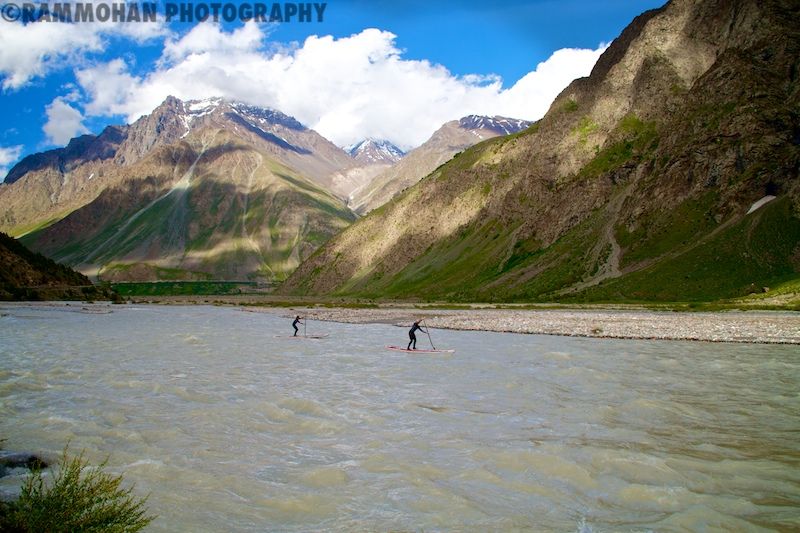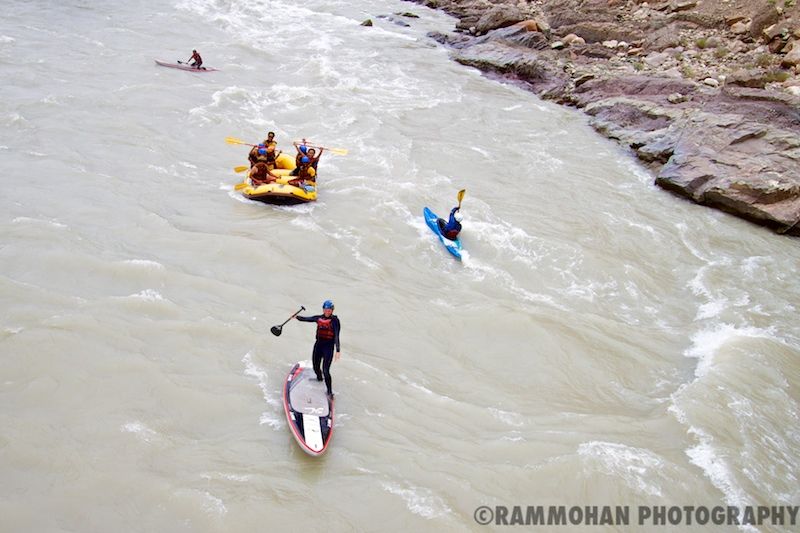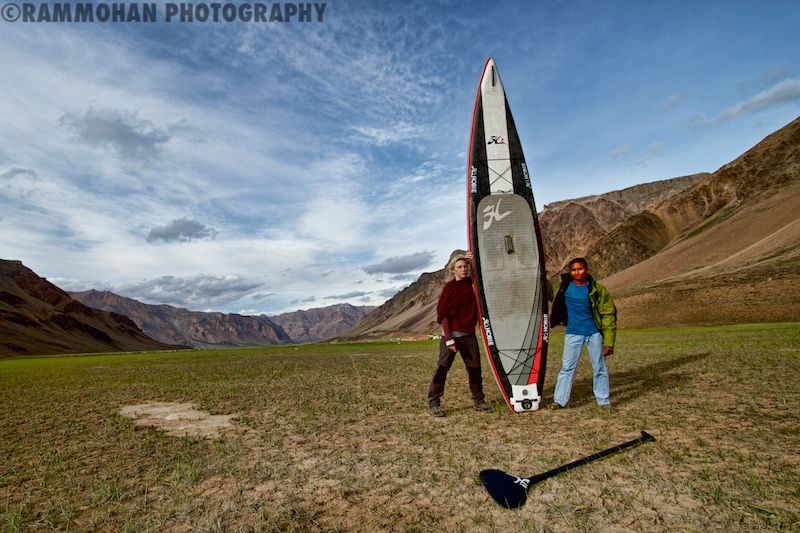Piolets d'Or Announces the "Significant Ascents" of 2023
This list of 68 climbs is effectively a "long list" used to select nominees of the prestigious alpine award.


# What was the first thing that crossed your mind when it came to SUPing in the Himalayas as this is originally a sea sport that you guys wanted to try out at high altitude?KiranTaking SUP to a whole new level and creating a world record.RamSUP is a very dynamic sport, although it is very much ocean-oriented because of it's origin, it can be easily done anywhere. Probably, the first thoughts were about paddling at high altitudes in extreme weather conditions and terrains which was going to be quite challenging for ocean dwellers like us.AprilThe scenery doesn’t count as the first thing that crossed my mind. While preparing for the trip I had thoughts about the altitude and the cold water. A few times I had thoughts about the inflatable boards and wondered if there would be any issues.# Did you find out if this has been done before at such altitudes?KiranWe did some research and nobody has come close to what we did, which is 16,000+ ft.RamWe looked very hard to find if it's been done in Himalayas and we couldn't find anything except there is a 16 second video of guys rafting in River Karnali in Nepal. I don't think it was a proper expedition, since it's not well documented. Coming to SUP paddling at altitudes, the closest we came was again 6,600 ft in Lake Utah. We are still trying to find some answers for highest altitude SUP paddling but we doubt if anything actually comes close to ours.AprilI’ve seen the River Karnali video on YouTube. Other than that, I can’t find any well-documented accounts of high altitude paddling. Most high-altitude paddles are in North America, and are based around the Sierra Nevada Mountains. All of these are under 7,000 feet. I’m still looking into it each day. I would love to get some feedback, and hopefully by getting the word out about this expedition, others may come forward and say what altitude they’ve paddled at.# When did this expedition begin? And what was going through your mind about the thought of SUPing in Himalayan waters?KiranJune 17th I caught up with April in Chandigarh (North India) for the expedition. That's when it began. I love trying new things in surfing and SUP.RamKiran and April held some SUP workshops in Chandigarh and soon started travelling up towards Himalayas. They had successful stints in Shimla, Dharamshala and Manali before I joined them in Manali and headed to Ladakh.AprilI was very upbeat about the fact that we will be doing something unique in these glacial waters/lakes and rapids just because of the varied landscapes, challenges it posed and the fun we were gonna have on this trip. I also knew in the end it was going to be very draining and exhausting.It all began on June 18th. However, I think it truly began when the team was all together in Manali. Everything up to that point wasn’t very substantial. I couldn’t stop thinking about the scenery, the altitude, and the water temperature. I also couldn’t wait to bring a new sport to the area. SUP is just catching on down South (India), and to introduce it to people up North was very exciting to me. Everywhere we went, we got excellent feedback and people loved trying out SUP.# What kind of study did you undertake of the region before the expedition began?KiranI knew about Ladakh from my friends and I did minimal study on weather, food, lakes, altitude and hardest rapid in the rivers.RamI have been to the region before and have some knowledge about the place but this time we were going at a very different time, when all the winter snow would be melting down the peaks with landslides, rains etc... Especially, after what happened in Uttarkhand (cloudburst/landslides killing thousands in June), many advised against going there at this time of the year. I don't know how many calls or messages I received but fortunately our travel went smooth without any major issues.AprilActually, this was part of the adventure for me. I hadn’t done much research because I was very busy with a few other projects. At first, I was relying heavily on the 'outdoor adventure' company that invited me to the area to provide me with the information I would need. When that company fell through and we were on our own, my study began at an expedited pace. I found out a lot about the area, the rain, the snowmelt, and all of the associated dangers – all once we were already en route! I was a little nervous, especially with the news from Uttarkhand. I, too, received countless messages asking if I was OK and to advise us to not be up in the area.# Have you ever been to the Himalayas before?KiranYes I have been to Jomsom, Nepal in 2001 with a group of friends from the Ashram and it was Surfing Swami's idea to go there. Well, we didn't do much in the waters in Jomsom and instead we went horse riding, mountain climbing and sightseeing.RamI have been to Ladakh, Zanskar mountain ranges but it was never an expedition or for trekking. It was 3 years back with couple of my friends and we visited monasteries, lakes, did biking. Nothing too adventurous.AprilNope! I had never been to the Himalayas before.# Could you tell us something about your other two SUP surfers (as people you have known and surfers)?RamKiran and I go back to our childhood days, where we grew up together, had many adventures and did many wonderful travels. He is India's premier surfer, an aquaholic and a great athlete. He isn't so talkative and remains quiet and calm.April is someone whom I met through our surfing activities down south this year. Obviously she is a great SUP athlete and the sport's ambassador here in India, she is quite determined about promoting the sport in the country. As a person, she is hyper energetic, fun and adventurous.AprilAs for Ram and Kiran, I couldn’t have asked for a better pair of people to come on this expedition with me. Kiran was right there through thicks and thins, and when I thought it all wasn’t going to work, he had the faith. Ram is very patient and gets things done when the language barrier (or the talk to women barrier) seems to be an issue. I haven’t seen Ram in the water much and we only spent a little bit of time together back in Kerala. But I stayed at the surf ashram with Kiran for over a month. I always felt like he was up for adventure, my kind of person! He’s an excellent surfer and a damn good athlete. The first long distance paddle I ever went on, he immediately wanted to go – no questions asked. He hopped on to my small board and paddled 12 miles out into the middle of the ocean to a set of rocks with no GPS and no complaints!# How did you guys decide to fund your expedition and what was the total cost incurred per person?KiranWell, at first we were told that we will get sponsored and the guys that we were working with turned out to be a big scam and later on we put money from our own pockets. April Zilg sponsored me and Ram, who is my good friend, was sponsored by Mantra Surf Club, Surf Adventure Enterprises. For Ram it costed him Rs 60,000 (USD 988) because he joined us from Manali, where as April and I started the expedition from Chandigarh, so I think it comes up to Rs 1 lakh (USD 1,646) each.RamWell, Initially we were supposed to be funded by certain individuals who were interested in promoting the sport etc... but it turned out to be a big scam. In the end, we ended up paying for our own expedition, pretty much. April covered Kiran's costs and I did mine.AprilSame story as Ram, the 'outdoor company' had arranged sponsors and opportunities for Kiran and I to give instructor certifications to make some money to offset the cost of the expedition, but that fell through. I know that we all paid a little more than we had bargained for, and if you take into account that I purchased the 4 SUP boards for this trip specifically.# Where did you guys begin SUP surfing from (during this trip) and how did you chose the first spot?KiranWell, April and I began Stand Up Paddling from Chandigarh with the help of local river guides/ rafters. Most of the time we had no idea what was coming for us but we preferred not knowing because its more exciting.RamThe expedition began from Shimla, Dharamshala and later I joined them in Manali to head towards Ladakh. Ladakh was always going to be the highlight and the expedition would actually begin on the way to Ladakh from Manali.AprilWe started stand up paddling in Chandigarh on a lake there. The real adventure began from Manali. The night we stopped for our first camp, the river alongside the camp looked very nice. We decided to wake up early and charge!# Any curious tourists/ locals approached you to find out what the hell you guys were doing?KiranThere were some tourists interested in SUPing on the way to Tsomoriri Lake. Some local kayakers in Ladakh were very interested and in fact they even charged the class 4 rapid with us, but sitting.RamMore than tourists, we had a lot of curious locals coming out cheering and trying the SUP themselves. One of the objectives of this expedition was also to promote SUP locally in the region. We even had mountain nomads in far east Ladakh trying SUP.AprilI was usually in the water, so I didn’t get a lot of questions. I heard locals cheering from the riverbanks when we were on the rivers. At a small lake before Tsomoriri was where I got the most questions. A couple from Europe had stopped and asked what tour I was on and how they could do SUP in the Himalayas! At this stop, some of the kids herding goats also stopped by and tried the boards out.

# What is the basic difference between SUPing in warm ocean currents and in high altitude lakes / gushing white water / glacial melt water?KiranOne of the thing was any water activities you do up in that high altitude and in freezing condition it just drains your energy twice as faster and I got into the water few times to test how long i can survive in that freezing water. I dont think I could last over 5 minutes. It was a little bit of a problem when we were charging white water that it was not that easy to flip our board and get back on the track, expecially in class 3 to 4. When we were in Pangong Lake, I went out swimming and I had issues there, I couldn't breath nor could I feel my legs or my hands for 10 minutes!RamSUPing in warm waters of ocean is obviously a little easier and comfortable since it's our familiar ground. Where as, mountains and high altitudes is a bit out of comfort zone... where, from weather to terrain...everything is different. The effort you put in high altitudes is 10x times more than what you do at sea level.AprilFalling in. In the warm southern oceans, falling in is just a part of learning. It’s fun, and sometimes you welcome it because you’re hot. The first time I fell in at the Indus, even though I had my wetsuit, it was an absolute shock. It took me a minute to catch my breath.# The toughest places you guys SUPed in the Himalayas!KiranI would say Suraj Tal was the toughest and also the whitewater in Indus River.RamPaddling at Suraj Tal at 16,000 ft was definitely very challenging. The weather was quite treacherous, we barely escaped a snow storm and it was middle of nowhere.AprilKiran and I had to climb down a rocky slope to get to the lake. Once there, it was freezing and the wind was howling. Then, while we were packing up and had to ascend the rocky slope, it started to snow! Turns out there was a storm brewing. Of course, though, trying to stand up through a class 4 rapid in the freezing Indus wasn’t easy either.# Do you see this as a potential sport (individual or part of a multi-disciplinary event) in the near future?KiranYes, Stand Up Paddling has potential, no doubt. We are looking forward to holding events in the near future. Surfing Swami is already planning a trip next year.RamOf course, we had an SUP race, SUP surfing at our inaugural surf event in Kerala. We hope to take this sport to every corner of India where ever there are water bodies. It is the fastest growing water sport currently in the world and we hope it catches up in India too.April100% yes! This is the world’s fastest growing watersport because it appeals to such a broad audience. People that get hooked will inherently want to enter some competitions, even if it’s just for fun.# Fill in the blanks: SUP surfing to me is _______. SUP surfing in the himalayas is _____!RamFun & EnthrallingAprilFreedom. Exciting.# What do you do on regular days (when not surfing)?RamA lot of planning, meetings and busy etching out the future of surfing in India.AprilPaddling is my regular day! When I’m done paddling, I’m designing some western beachwear and accessories that are made in India with Indian fabrics. The funds from this are going to make very modest swimsuits for underprivileged girls in India that take up surfing (right now, the suits will go to the orphans from Homes of Hope that participate in the yearly IndoJax Surf Charity).# Which are the other places in the world that (you think ) are conducive for high-altitude SUP surfing?RamDefinitely South America! It's got the world's highest lakes. There is Gurudongmar at 17,100 ft at Indo-Tibetan border. There are a few more impressive water bodies in Tibet.AprilAgree with Ram. However, if you do some searches for high altitude SUP, most are in the 7,000 ft range. We’re interested in going higher, and maybe hosting a race at a higher altitude.

# Describe your gear and equipment?RamMy camera gear had Canon 7D, with wide angle lens 10-22 mm, 18-200 mm, 70-200 mm. We had Go Pros, a water camera.AprilApart from that, we had four inflatable Hobie SUP boards which was quite a task to lug them around. Helmets, wetsuits, life jackets, first aid. For SUP we had 4 Hobie 12’6” Inflatable boards with 3 piece adjustable paddle, removable fin, and pump. Each paddler in whitewater was fitted with a life vest and helmet. The life vest is also somewhat SUP specific, being that most of the floatation is in the chest and shoulder area, leaving the space below the arms clear for paddling motion. In the white water we also ran 3mm wetsuits.Under my wetsuit I had put on my Under Armor compression leggings and Arc’Teryx base layer. To keep my feet warm, I also had 5mm Xcel split toe surf booties on. Feet are the first thing to get cold, so a thicker layer down there is a MUST. Also, I prefer the split toe design for SUP because it’s a little more like bare feet and you can get better balance by having some more freedom in your big toe.I also brought my GoPro Hero and GoPro Hero 3 cameras to film a lot of the action. However, in terms of water cameras – I really love my Nikon Coolpix AW100.# Any injuries sustained during the expedition? What was in your medical kit and survival kit?RamFortunately no big injuries, only bruises. April had some knee issues at the end. I think we are good at handling ourselves and taking enough precautionary measures. We had a basic medical kit.AprilNo injuries. I think my knee hurt because I sat on a motorcycle in an odd position for about 6 hours! Basic medical kit. The good thing about SUP boards is that they actually double as so many different things! They are great for water rescue (same as a life guard rescue board essentially), can be used as a backboard for spinal injuries or even used as an air mattress in a cold camping situation!# Any scary / memorable moment you can share while SUPing the Himalayas?RamKiran and April sliding down the snow on their SUP's was quite a memorable moment. Kiran went topless too in freezing conditions. They might have had some moments while coming down at class 4 rapids on their SUP's too.AprilI did enjoy taking the board out in the snow. However, I’d have to say the first time I came around the bend in the rapids and didn’t know what to expect. I lined the board up wrong and ended up broad side getting turned over into the first class 3. The shock of falling in such cold water literally took my breath away.# Fill in the blanks: I am ______? RamAn intrepid traveller who got a new nick name MOMOS (Tibetian steamed dish) on this trip.AprilA crazy blonde chick.Image Courtesy © Rammohan PhotographyPlace: New Delhi
2nd best newsletter in the universe